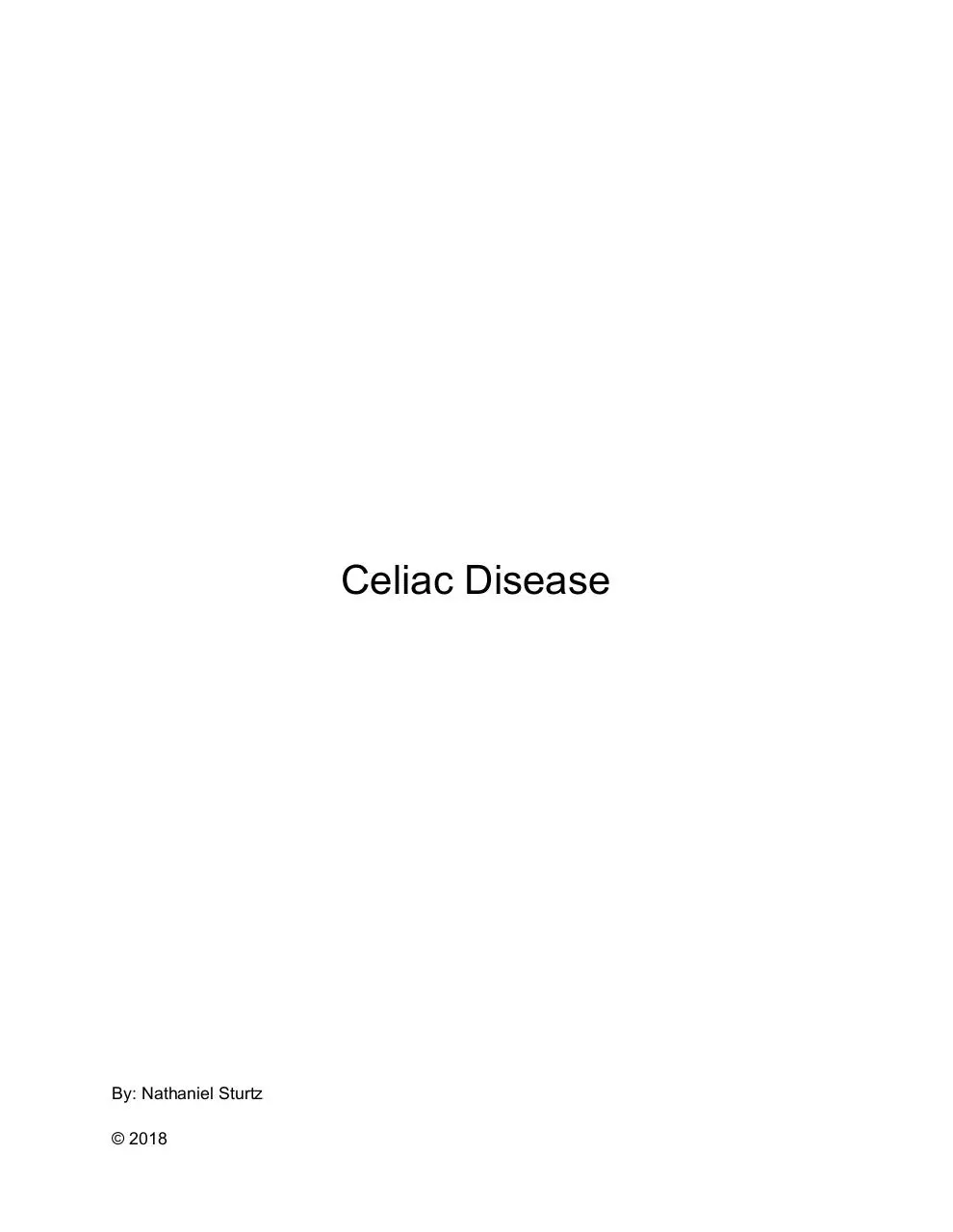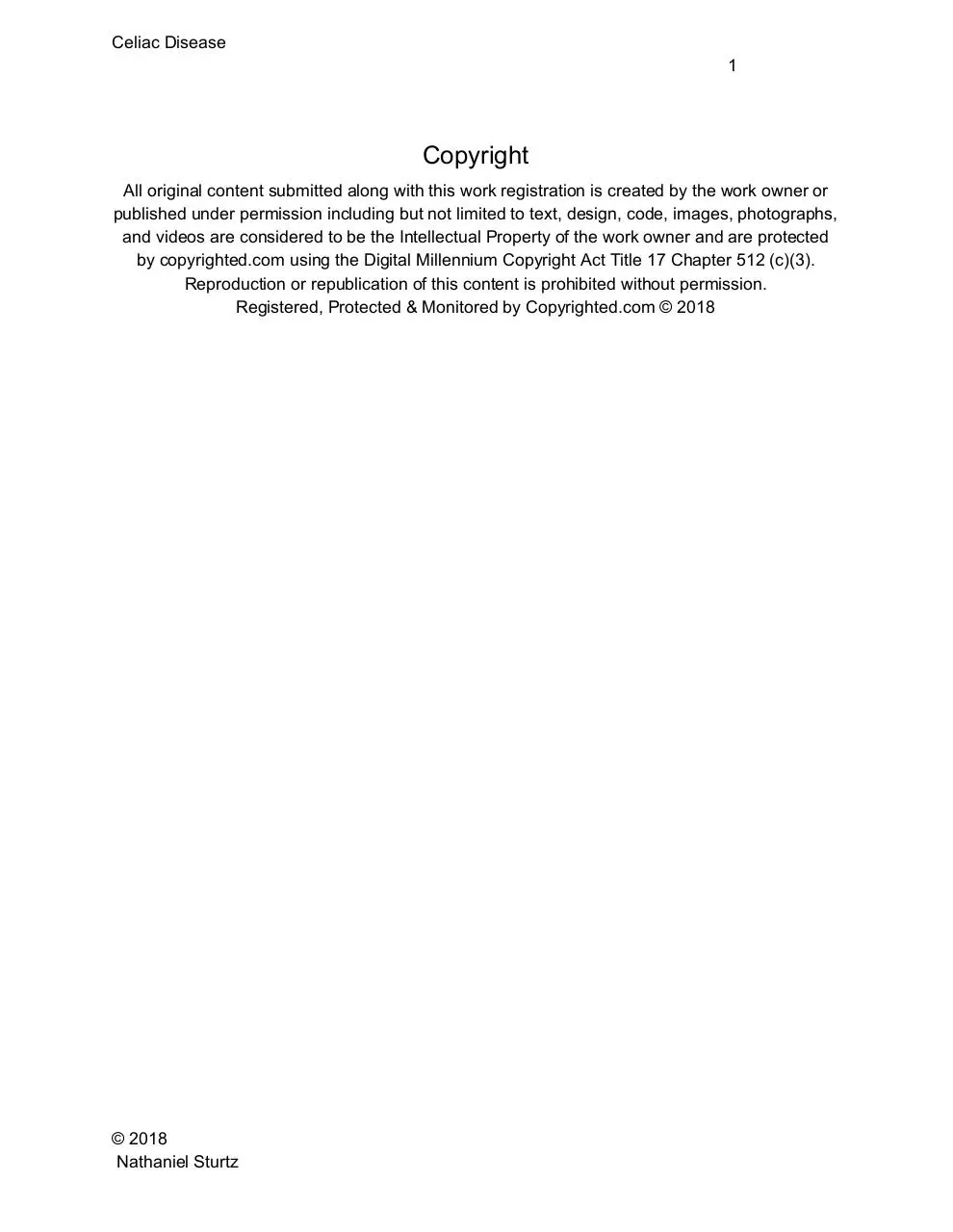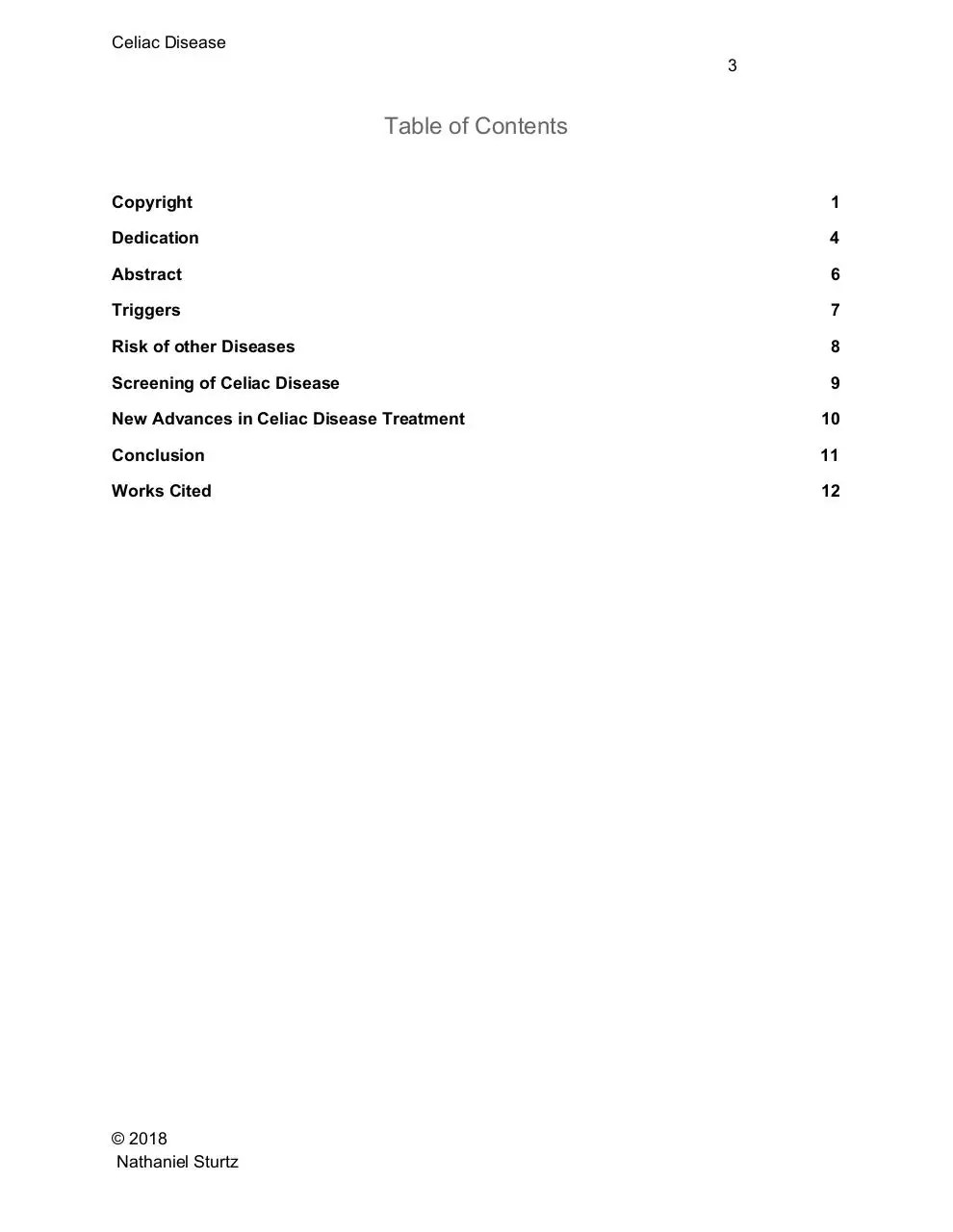Celiac disease (PDF)
File information
This PDF 1.5 document has been generated by / Skia/PDF m71, and has been sent on pdf-archive.com on 25/09/2018 at 18:17, from IP address 40.138.x.x.
The current document download page has been viewed 330 times.
File size: 102.28 KB (14 pages).
Privacy: public file





File preview
Celiac Disease
By: Nathaniel Sturtz
© 2018
Celiac Disease
1
Copyright
All original content submitted along with this work registration is created by the work owner or
published under permission including but not limited to text, design, code, images, photographs,
and videos are considered to be the Intellectual Property of the work owner and are protected
by copyrighted.com using the Digital Millennium Copyright Act Title 17 Chapter 512 (c)(3).
Reproduction or republication of this content is prohibited without permission.
Registered, Protected & Monitored by Copyrighted.com © 2018
© 2018
Nathaniel Sturtz
Celiac Disease
2
© 2018
Nathaniel Sturtz
Celiac Disease
3
Table of Contents
Copyright
1
Dedication
4
Abstract
6
Triggers
7
Risk of other Diseases
8
Screening of Celiac Disease
9
New Advances in Celiac Disease Treatment
10
Conclusion
11
Works Cited
12
© 2018
Nathaniel Sturtz
Celiac Disease
4
Dedication
I dedicate this paper to my family, especially my Grandma Sturtz.
© 2018
Nathaniel Sturtz
Celiac Disease
5
© 2018
Nathaniel Sturtz
Celiac Disease
6
Abstract
Celiac an incurable disease a gluten intolerance is associated with the disease called
gluten-sensitive enteropathy. It is caused by an abnormal immune response to gluten, which is
a component of wheat and some other grains. When the body's immune system overreacts to
gluten in food, the reaction damages the tiny, hair-like projections that line the small intestine. 1
© 2018
Nathaniel Sturtz
Celiac Disease
7
Triggers
People with celiac disease carry one or both of the HLA DQ2 and DQ8 genes, but so
does up to 25-30% of the general population. Carrying HLA DQ2 and/or DQ8 is not a diagnosis
of celiac disease nor does it mean you will ever develop celiac disease. However, if you carry
HLA DQ2 and/or DQ8, your risk of developing celiac disease is 3% instead of the general
population risk of 1%.2
Since celiac disease is genetic, this means it runs in families. First-degree family
members (parents, siblings, children), who have the same genotype as the family member with
celiac disease, have up to a 40% risk of developing celiac disease. The overall risk of
developing celiac disease when the genotype is unknown is 7% to 20%.2
Celiac Disease can be triggered by or can become active for the first time after, surgery,
pregnancy, childbirth, viral infection. 1
© 2018
Nathaniel Sturtz
Celiac Disease
8
Risk of other Diseases
Individuals with Celiac Disease are at increased risk of non-alcoholic fatty liver disease
(NAFLD) compared to the general population, excess risk is highest in the first year Celiac
Disease diagnosis but persist throughout 15 years the diagnosis of celiac disease. Patients with
celiac disease have an almost 3% increase in the risk of developing pancreatitis.
Autoimmune thyroid disease and type I diabetes mellitus are the most common
autoimmune diseases that occur with celiac disease. People with Celiac Disease have 2.4%
increased risk for type I diabetes mellitus before they are 20 years old. Celiac Disease is
observed in approximately 7% of patients with autoimmune thyroid disorders. Associations with
Sjögren syndrome, Addison’s disease, parathyroid disorders, and growth hormone deficiency
also have been reported.
Celiac Disease affects approximately 2.5% of cirrhotic patients. A study has shown that
liver diseases are most commonly associated with Celiac Disease. Irritable bowel syndrome
(IBS)-type symptoms occur frequently in patients with Celiac Disease and are more common
than the general population. Нe pooled prevalence of IBS-type symptoms in all patients with
Celiac Disease is 38.0 %. Celiac Disease is associated with small intestinal bacterial overgrowth
(SIBO). In a study, it has been shown that a large number of celiac patients from North India
suffers from a bacterial overgrowth of 20.7% which can be accordingly treated with antibiotics.
© 2018
Nathaniel Sturtz
Celiac Disease
9
Screening of Celiac Disease
Screening of Celiac Disease Should be considered in patients with symptoms, signs or
laboratory evidence suggestive of malabsorption. Patient with a first-degree family member who
has a confirmed diagnosis of Celiac Disease and showing possible signs or symptoms or
laboratory evidence of Celiac Disease. Celiac disease should be sought among the
explanations for elevated serum aminotransferase levels when no other etiology is found.
Patients with Type I diabetes mellitus (DM) should be tested for Celiac Disease if they have any
digestive symptoms and signs or laboratory evidence suggestive of Celiac Disease.1
© 2018
Nathaniel Sturtz
Celiac Disease
10
New Advances in Celiac Disease Treatment
Newer Strategies include developing agents to degrade or alter dietary gluten, prevent gluten
peptides from crossing the epithelial barrier, inhibit tTG-induced potentiation of gliadin peptides
or block gliadin binding to HLA-DQ2. Immune-based strategies involve preventing T-cell
activation or innate and adaptive immune responses. However, only 2 agents are in late phase
2 clinical trials. ALV003 (2 recombinant, orally administered, Gluten-specIfic proteases) is given
orally, reduce the small intestinal mucosal injury caused by 6 weeks of gluten challenge.
Larazotide acetate, an oral peptide that modulates intestinal tight junctions, reduce symptoms in
patients who are symptomatic despite a GFD. Additional studies are underway to determine if
these agents are safe and elective for patients with persistent symptoms and mucosal injury
despite a continued GFD. Нese or other electIve therapies could reduce the burden of GFD by
decreasing the effects of inadvertent gluten exposure. Monitoring of celiac disease: Celiac
Disease is a lifelong Inflammatory condition that affects multiple organ systems, so patients
should be followed up routinely. Serologic testing should be done every 3-6 months until normal
and then every 1-2 years. Nutritional evaluation for iron, vitamin B12, folate etc. should be done
every 3-6 months until it becomes normal. Low bone mineral density is one of the more common
extraintestinal manifestations of celiac disease, so dual-energy x-ray absorptiometry (DXA)
evaluation generally is recommended in the first year aіer diagnosis. НyroLd functions
monitoring should be done first at diagnosis and then in every 1-2 years. Нe optimal timing of
the follow-up biopsy is unclear as all celiac disease patients do not reach mucosal recovery in 1
year time despite a strict gluten-free diet. In patients with high dietary adherence, incomplete
villous recovery aіer 1 year does not affect the clinical response or long-term prognosis so
personalized approach is required to decide the optimal timing of the follow-up biopsy. Thus
careful evaluation is needed to identify and treat the specific source in any given patient. Нe first
step in evaluation is to re-confirm the initial diagnosis of Celiac Disease by review of
small-intestinal histology and serology obtained at the time of diagnosis.
© 2018
Nathaniel Sturtz
Celiac Disease
11
Conclusion
Celiac is a un-curable disease. It is a gluten hypersensitivity that simplified is a gluten allergy.
\
© 2018
Nathaniel Sturtz
Celiac Disease
12
Works Cited
1.Nijhawan, Goyal. “Celiac Disease Review.” JGDS-15-1373, 2015,
pdfs.semanticscholar.org/3af7/34d87b353afe2b9fd877460c0dfda6d61559.pdf. Date
accessed: 21 September 2018
2. “Screening.” Celiac Disease Foundation,
celiac.org/. Date accessed: 21 September 2018
© 2018
Nathaniel Sturtz
Celiac Disease
13
Other Translations
Chinese
Spanish
© 2018
Nathaniel Sturtz
Share this file on social networks
Link to this page
Permanent link
Use the permanent link to the download page to share your document on Facebook, Twitter, LinkedIn, or directly with a contact by e-Mail, Messenger, Whatsapp, Line..
Short link
Use the short link to share your document on Twitter or by text message (SMS)
HTML Code
Copy the following HTML code to share your document on a Website or Blog
QR Code to this page

This file has been shared publicly by a user of PDF Archive.
Document ID: 0001898759.